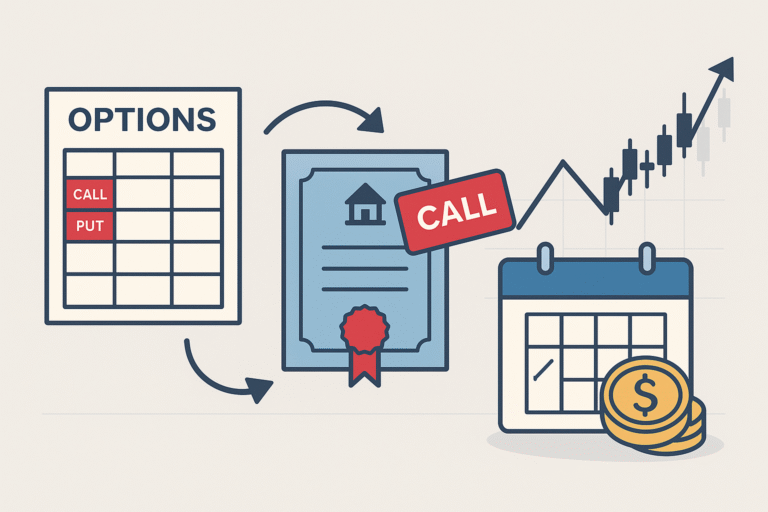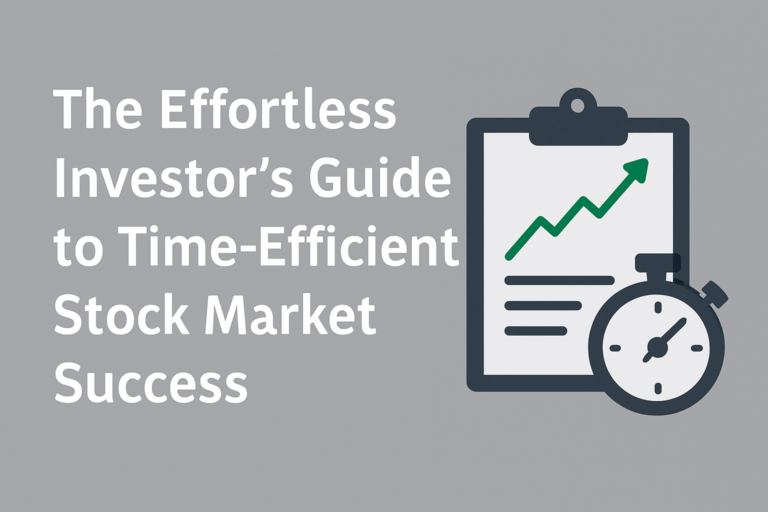Efficient Stock Trading for Busy Investors: Time-Saving Strategies to Grow Your Wealth

Efficient Stock Trading for Busy Investors
In today’s fast-paced world, efficient stock trading for busy investors is more crucial than ever. Busy professionals often find themselves overwhelmed with work commitments, leaving little time to manage their investment portfolios actively. Efficient stock trading allows individuals to grow their wealth without needing constant involvement, offering a valuable solution for those with packed schedules.
Time constraints often hinder the ability to research, monitor, and trade stocks regularly. As a result, there’s a need for strategies that demand minimal time investment while still reaping substantial rewards. This blog aims to deliver actionable strategies and shortcuts for stock market trading, enabling investors to participate effectively without compromising their demanding jobs.
Understanding Efficient Stock Trading
What Makes Stock Trading Efficient?
Efficient stock trading emphasizes optimizing time and resources to manage investments effectively without continuous oversight. It incorporates strategic planning, leverages automation, and makes use of low-maintenance investment vehicles like Exchange Traded Funds. By focusing on these elements, investors can maintain a hands-off approach while still achieving their financial goals.
Importance of Time Management in Trading
Balancing trading with work responsibilities is crucial. Frequent, unnecessary trading can lead to disrupted schedules and increased stress. Efficient tactics ensure that traders meet their financial objectives with minimal effort and anxiety.
Key Principles for Maximizing Trading Efficiency
- Focus on Long-Term Growth: Minimize frequent monitoring by prioritizing sustainable, long-ranging investments.
- Use Automation Tools and Robo-Advisors: Streamlining investment processes through technology reduces manual workload.
- Prioritize Quality Investments: Select assets that align with individual financial goals and risk tolerance to ensure peace of mind and potential growth.
How to Trade ETFs with Limited Time
What Are ETFs and Why They’re Ideal for Busy Investors
Exchange-Traded Funds (ETFs) are bundles of securities traded on exchanges much like individual stocks. For busy investors, they offer several benefits:
- Instant Diversification: Spread risk across various assets instantly.
- Lower Expense Ratios: Provide cost-effective investment solutions compared to mutual funds.
- Ease of Trading: ETFs can be quickly traded during market hours.
Step-by-Step Guide to Trading ETFs Efficiently
- Identify Investment Goals: Determine your primary objectives, such as growth, income, or specific sector exposure.
- Select ETFs Wisely: Base your choice on past performance, expense ratios, and alignment with personal investment sectors.
- Tip: Opt for ETFs with consistent returns and low fees.
- Utilize Dollar-Cost Averaging: Regularly invest a fixed amount to mitigate the impact of market fluctuations.
- Avoid Trading During Volatile Times: Stay away from market open and close when prices are most volatile.
Recommended Tools and Platforms for Simplified ETF Trading
Platforms like Webull and Vanguard are ideal for ETF investors. They provide intuitive interfaces for tracking ETF performance, executing trades, and accessing valuable educational materials. Explore more on efficient trading platforms, and consider learning from resources like Investopedia’s Day Trading Strategies for Beginners and Vanguard’s ETF Trading Strategies.
Tips for Selecting the Right ETFs
- Assess Historical Performance and Liquidity: Ensure ease of buying and selling through high liquidity.
- Consider the Expense Ratio: Lower expenses contribute significantly to long-term gains.
- Align with Risk Tolerance and Investment Horizon: Choose ETFs that match your risk comfort level.
Options Trading Strategies for Working Professionals
Introduction to Options Trading and Its Potential Benefits
Options trading involves buying and selling contracts that provide the right but not the obligation to purchase or sell an asset at a predetermined price by a certain date. For busy professionals, options trading can:
- Yield higher returns with a more modest investment.
- Offer flexibility to hedge against market volatility.
- Present an opportunity for additional income streams through premiums.
Learn more about leveraging options in your strategy here.
Simple and Effective Options Trading Strategies
- Covered Calls: Own a stock and sell call options on the same stock. This strategy generates income while holding the equity, ideal for those ready to sell at a set price. Refer to Investopedia – Options Strategies for more details.
- Protective Puts: Buy a put option for a stock you own. As a form of insurance against price drops, this is suitable for those cautious about protecting their investments. See Charles Schwab – Options Trading Strategies for guidance.
- Vertical Spreads: Buy and sell options of the same type and expiration with differing strike prices. These can restrict losses and lower initial capital needed. More information can be found at Investopedia – Options Strategies.
Risk Management Techniques in Options Trading
- Set Maximum Acceptable Losses: Establish and maintain strict stop-loss limits.
- Diversify Strategies: Avoid concentrating all investments in a single strategy.
- Educate Before Speculating: Ensure you understand complex strategies before engaging.
Staying Informed Efficiently
- Listen to Financial Podcasts and Subscribe to Newsletters: Get market news during commutes or breaks.
- Utilize Subscription-Based Research Platforms: Access in-depth analyses swiftly.
Related Reading:
👉 How to Start Investing with Limited Time
👉 Step-by-Step Options Guide
👉 Risk Management Strategies
Shortcuts for Stock Market Trading
Leveraging Automation and Robo-Advisors
Automating trades and portfolio management significantly reduces the time burden of manual market research. Robo-advisors, such as Wealthfront, cater portfolios to individual risk profiles, thereby easing management tasks. Learn how to implement these tools here.
Utilizing Mobile Apps and Alerts for Real-Time Updates
Platforms like Interactive Brokers provide mobile applications equipped with real-time data and custom alerts for key market changes. Set up notifications for pricing shifts, news, and technical developments. Find out more about these tools here, and explore strategies at Investopedia – Day Trading Strategies for Beginners and Vanguard’s Considerations for ETF Trading Strategies.
Implementing Pre-Set Trading Plans and Algorithms
- Use Stop-Loss and Take-Profit Orders: Automatically execute trades to manage losses or lock in profits.
- Algorithmic Trading: Follow pre-designed strategies to execute orders without emotion, ultimately saving time. Watch this insightful video on 5 Ways to Start Investing with Little Money.
Time-Saving Research Methods
- Follow Trustworthy Analysts: Save time by referencing reliable sources.
- Curated News Platforms Like Morningstar: Quickly access crucial updates without exhaustive searching. To learn more check out Investopedia’s Day Trading Strategies for Beginners.
Tools and Technologies for Efficient Trading
Overview of Essential Trading Tools
Trading Platforms:
- Webull: Known for commission-free trading, advanced tools, and instant market data access.
- Vanguard: Focused on ETFs and offering low-cost, long-term investment opportunities.
- Interactive Brokers: Offers broad investment options and top-level trading tools.
Analytics Software:
- TradingView: Provides advanced charting features and social networking capabilities.
Calendar Apps:
- Track critical dates such as earnings and economic reports with syncing options for convenience.
Integration into a Busy Lifestyle
- Use Mobile-Friendly Platforms: Access portfolio data on-the-go.
- Set Notifications for Important Updates: Stay informed without active monitoring.
- Schedule Regular Check-Ins: Manage investments efficiently with brief, consistent reviews.
Recommendations for Tools Tailored to Busy Investors
- Vanguard for ETFs: Offers simple, long-term investment-focused interfaces.
- Charles Schwab for Options Trading: Robust options analysis and educational content.
- Webull for Real-Time Updates: Delivering news and market data promptly.
Best Practices for Maintaining Trading Efficiency
Establishing a Consistent Trading Routine
- Allocate Fixed Time Slots for Investment Activities: E.g., devote 15 minutes each morning to market reviews.
- Stick to Your Schedule: Consistency assists in improving decision-making and avoiding burnout.
Prioritizing High-Impact Trading Activities
- Concentrate on Major Portfolio Changes: Avoid constant small trades with negligible impacts.
- Emphasize Quality Over Quantity: Research thoroughly and invest wisely rather than relying on chance.
Continuous Learning and Strategy Adaptation
- Stay Updated with Concise Market Trend Reports: Use newsletters or briefings.
- Engage in Further Education: Online courses or webinars on efficient trading strategies.
- Network with Fellow Investors: Share insights for broader perspectives.
Conclusion
To summarize, efficient stock trading for busy investors involves leveraging methods like ETF and options trading, combined with modern technology. By focusing on highly effective and simplified strategies, busy professionals can optimize trading performance without extensive time investments. Begin implementing these methods now to advance toward your financial goals with greater efficiency and minimal disruption.
Additional Resources
Trading Platforms:
Suggested Readings and Courses:
- ETFs: Investopedia – Exchange-Traded Funds (ETFs)
- Options Trading: Investopedia – Options Trading Introduction
- Investing Automation: Wealthfront – Automated Investment Management
Contact Information for Personalized Trading Consultations:
- Engage with certified financial advisors for tailored strategies.
- Join communities like Reddit’s r/investing for peer support.







